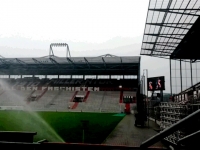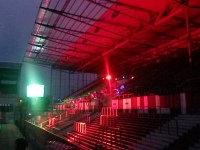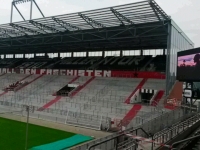UNFAMILIAR SHOW
Selected Works from the MOMENTUM Collection
2 – 5 July 2015
At Millerntor Gallery
Heiligengeistfeld 1, 20359, Hamburg

Featuring:
Eric Bridgeman // Nezaket Ekici // Theo Eshetu
Amir Fattal // Gülsün Karamufa // Tracey Moffatt
Martin Sexton // Sumugan Sivanesan
 |
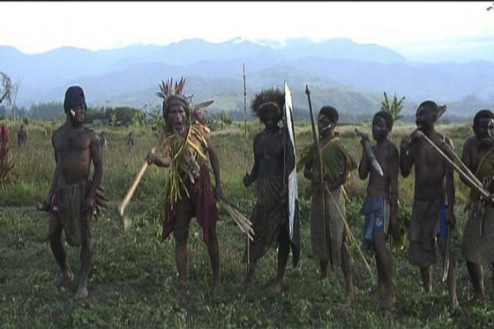
ERIC BRIDGEMAN
Eric Bridgeman is a multi-disciplinary artist born in Papua New Guinea and currently based in Brisbane, Australia. Bridgeman commenced his Bachelor of Photography at the Queensland College of Art in 2005, majoring in Art Practice under the guidance of Ray Cook, Marian Drew and Jay Younger. He spent his final year in 2008 experimenting in Interdisciplinary Sculpture, which saw the beginnings of his works for The Sport and Fair Play of Aussie Rules (2008/09). In 2008, the Institute of Modern Art (Brisbane) selected this work for inclusion in The New Fresh Cut, giving Bridgeman the exposure and support to further the two-year long project. From this breakthrough opportunity, Bridgeman’s work attracted support and opportunities from organizations and institutions such as Next Wave Festival (Melbourne), Gallery 4A (Sydney), Australia Council for the Arts, Australian Centre for Photography (Sydney) and the University of Queensland Art Museum (Brisbane).
The Fight, 2008
In 2009, Bridgeman traveled through remote parts of the Chimbu Province, his mother country, in the Highlands of Papua New Guinea. As he was born in Australia, he became increasingly conscious of his own “white” Australian presence. The Fight is based on ethnographic conventions, from National Geographic to Irving Penn, which once aided in the promotion and consumption of PNG as Australia’s next frontier. Bridgeman filmed two groups of men from his own clan, the Yuri. Through acting out Western stereotypes of tribal war, The Fight parodies the history of representation and the subsequent impact on the national and cultural identity of PNG.
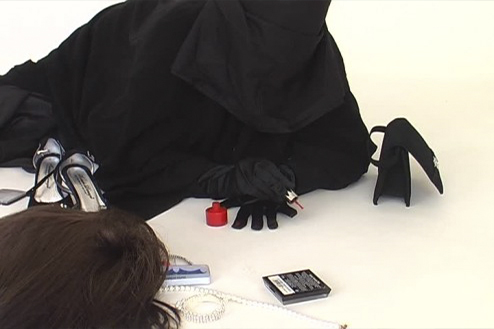
NEZAKET EKICI
Nezaket Ekici’s video, installations and performances are often process-based and ask viewers to derive their own emotional and intellectual interpretations. In her work, complex, often controversial topics are suspensefully countered by their aestheticizing presentation. Ekici frequently uses her own Turkish origins and education as a subject of tension, pitting her background against her living environment in present-day Germany. Cultural, geographic and individual boundaries, transgressions, gender, cross-border connections and authorial bodies are central to Ekici’s works. By highlighting these themes in everyday life and placing them in a new context, she aims to interconnect every element to form a total work of art — a Gesamtkunstwerk. Born in Kırşehir, Turkey in 1970, Ekici studied art pedagogics, sculpture and performance in Munich and Braunschweig, Germany. She then began working with performance and completed a master’s degree in Performance Art with Marina Abramovic. She has exhibited internationally, with a total of more than 120 different performances on 4 continents in more than 100 cities and 30 countries. She currently lives and works in Berlin and Stuttgart.
Veiling and Reveiling, 2010
Whether in Germany or in the artist’s native Turkey, the question of the Tschador’s meaning and effects remains controversial. How do streamlined notions of feminine beauty intersect with a headscarf’s political and religious references? For Ekici, stories of Turkish students donning wigs to conceal their forbidden headscarves at university, or methods of transporting beauty goods beneath the veil, have led her to question if women can ever truly wear head coverings out of free will. In the video performance Veiling and Reveiling, Ekici wears a Tschador in which various items are concealed: a wig, make-up, bag, bra, dress, tights, jewelry, shoes, artificial eyelashes. The video begins when the individual pieces are produced from the pockets of the Tschador and concludes when the veil has been fully redecorated, a willful inversion of public and private space.

THEO ESHETU
Theo Eshetu was born in London 1958, and grew up in Addis Ababa, Dakar, Belgrade and Rome. He now lives and works in Berlin. Forging a hybrid language to merge practices of video art and documentary filmmaking, Eshetu explores perception, identity, and notions of the sacred through electronic time-based media and optical devices and effects. He draws from anthropology, art history, scientific research, and religion—Catholic, African, Muslim, Buddhist—to explore clashes and harmonies of human subjectivity between world cultures in the global context. Though essentially conceptual, Eshetu’s work is often focused on cultural displacement, and is always grounded in compelling aesthetic components, often achieved through fractal repetition, such as kaleidoscopic mirroring, multi-screen projections, or mosaic-like patterning of images.
Questa è vita [That’s Life], 1986
Both Resignation and Affirmation, this early experimental video work by Theo Eshetu faces the inherently racist quality of television headon, transforming it into a celebratory Anthem of Black pride. Part biographic expression of interracial conflicts, the artist seeks an understanding of a video poetic through ritual, make-up, gestures, postures and dances, clothes, nudity and the blury pixels of the video signal. This work aims to both destroy and celebrate the possibilities of an a Art for Television : QUESTA E’ VITA (which synonymously in Italian sound like Questa e’ Video, This is Video,) explores new forms of video-making and the artist’s search for a new video language by going back to his African roots. Following the form of American Jazz musicians experimenting with new sound by going back to their African roots and the early cut-up method of hip Hop musicians, Questa e’ Vita is a Pop Video to Art Blakey’s drum solo in “Orgy in Rhythm”. [TE]
Whereas Theo Eshetu is a contributing artist to the MOMENTUM Collection, Questa è vita is not represented in the Collection.
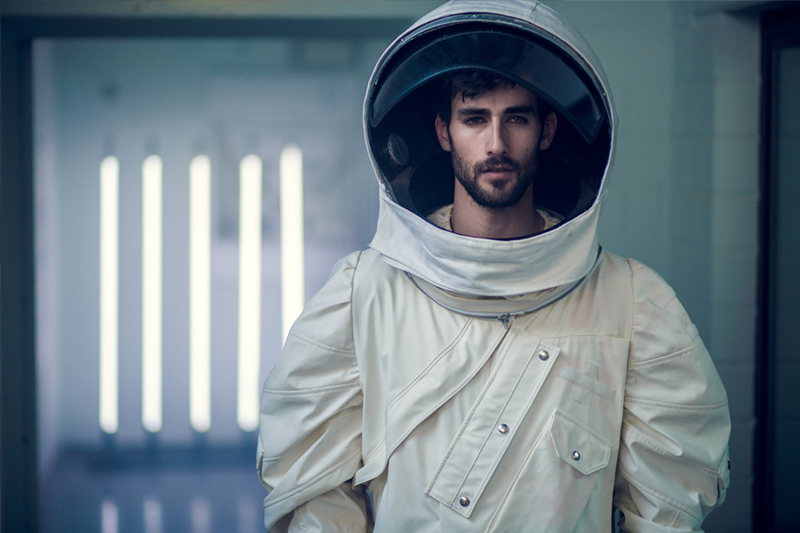
AMIR FATTAL
Amir Fattal was born in Israel in 1978, and is currently based in Berlin. Fattal graduated from Universität der Künste, Berlin, in 2009, and is a conceptual artist whose practice is one of historical reflection grounded in the history of aesthetics and cultural schisms. Fattal’s overarching concerns are the cultural connections between Germany and Israel – countries inexorably linked through their history, memory,
culture, architecture, and the geographical diaspora which resulted in mass migrations, transposing cultures to new and different nations.
Atara, 2015
The video installation Atara is dealing with different layers of the concept of resurrection in the context of German history. It combines together a reversed version of the Liebestod song from the opera “Tristan und Isolde” by Richard Wagner – that Fattal previously recorded together with an orchestra at the Berliner Funkhaus – together with a video taken at the workshop of the Berliner Stadtschloss in Spandau, where the new Baroque-style stone facade of the Stadtschloss is currently being rebuilt. The word Atara in Hebrew means crown, which is used in a famous Talmud expression meaning “restore to it’s former glory“. The video is dealing with a process that is taking place ‘out of time‘ or ‘out of space‘, in this case, breaking the historical narrative of creation and destruction in the context of two buildings that used to stand at the same place in Berlin: the Berliner Stadtschloss and the Palast der Republik. Their story brings together different epochs in the political history of Berlin and their aesthetics reflect the changing ideologies that they used to represent. It is asking the question: what does it mean to build a Baroque style palace in the year 2015 in a state with no monarchy? [AF]
Whereas Amir Fattal is a contributing artist to the MOMENTUM Collection, Atara is not represented in the Collection.
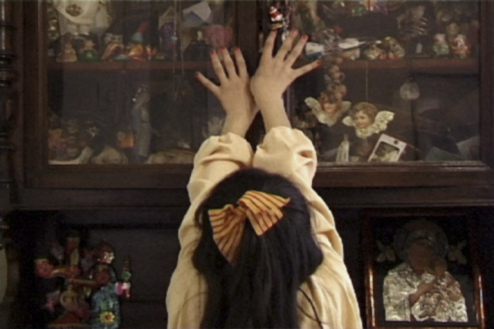
GÜLSÜN KARAMUSTAFA
Gülsün Karamustafa was born in 1946 in Ankara, Turkey. She lives and works in Istanbul, where she is recognized as one of the most important and pioneering Turkish contemporary artists. Her work addresses questions of migration, displacement and military dictatorship (during the 1970s she was imprisoned by the Turkish military). She was refused a passport for sixteen years until the mid-80s and, unlike other Turkish artists, could not emigrate or travel. This enforced isolation led her to an analysis of her own situation and context: the city of Istanbul, interior migration and nomadism within Turkey, and the ideological and psychological ramifications of identity. Like a sociologist or anthropologist, Gülsün Karamustafa explores the historical and social connections of oriental cultures in her works, often using materials that express the hybrid character of different cultures and religions. Ostensibly reverting to historical lore, Karamustafa’s artistic comments oscillate actually between sensual meta-narratives and ironic-critical stories about the present situation, addressing themes of identity and migration, cultural difference and acculturation within the contexts of orientalism and post-colonialism. Since the end of the late 1990s, she has often used already existing materials and images of oriental or occidental origin that she fragments, dismantles and reassembles in order to contrast ‘private’ with ‘public’ by referring to every-day life, culture, art history, and the media.
Personal Time Quartet, 2000
The video and sound installation Personal Time Quartet is designed as an ever-changing soundscape to accompany continually repeating images of a never-ending childhood. The sound was composed especially for this work by Slovak rock musician, Peter Mahadic. Comprised of various sound-samples (some of which are from rock concerts), each track was made to activate one of the four channels of moving image. The work is installed in such a way that each time the work is turned on anew, the four channels never synchronize, instead producing each time a new quartet to accompany the looping images. The four-part video Personal Time Quartet is concerned with the point of in- tersection between the artist’s own personal biography and the history of her home country. Having been invited to an exhibition of German domestic inte- riors from various periods in the twentieth century at the Historical Museum in Hanover, Karamustafa was inspired by what she saw there to take a closer look at the similarities between her own childhood reminiscences and these muse- ological German living spaces. The timeframe (or ‘personal time’) covered by these four video’s begins in the year of her father’s birth and ends in the early days of her own childhood. A video screen placed in each of the rooms shows the same young girl – the artist’s alter ego – engaged in various activities. We see her skipping with a skipping rope (dining room, 1906), sorting and folding laundry (kitchen, around 1913), opening cupboards and drawers (living room and parents’ bedroom, around 1930) and painting her nails (room from the 1950s). The films themselves, however, were not shot inside the museum, but rather in her apartment in Istanbul. Viewing them therefore gives rise to the most diverse associations. The girl skipping suggests a carefree childhood, the nail-painting a concern with the artist’s own femininity, the folding of laundry could be read as preparation for her future role of housewife, while opening cupboards and drawers is a way of discovering the hidden secrets and stories that are so much a part of our recollections of childhood and adolescence. In this installation, therefore, Karamustafa not only debunks the local or national specificity of certain styles, but at the same time exposes just how similar the evolution of (female) identity can be, even in very disparate cultures.
Barbara Heinrich,from Gülsün Karamustafa. My Roses My Reveries,Yapi Kredi Kültür Sanat Yayıncılık A.Ş, Istanbul, 2007.
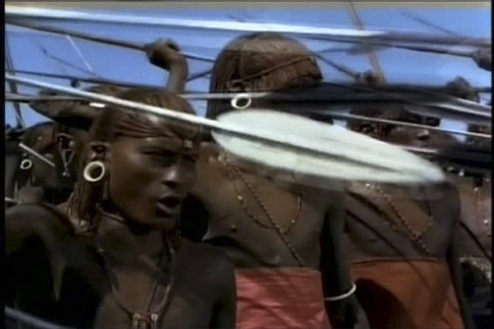
TRACEY MOFFATT
Gülsün Karamustafa was born in 1946 in Ankara, Turkey. She lives and works in Istanbul, where she is recognized as one of the most important and pioneering Turkish contemporary artists. Her work addresses questions of migration, displacement and military dictatorship (during the 1970s she was imprisoned by the Turkish military). She was refused a passport for sixteen years until the mid-80s and, unlike other Turkish artists, could not emigrate or travel. This enforced isolation led her to an analysis of her own situation and context: the city of Istanbul, interior migration and nomadism within Turkey, and the ideological and psychological ramifications of identity. Like a sociologist or anthropologist, Gülsün Karamustafa explores the historical and social connections of oriental cultures in her works, often using materials that express the hybrid character of different cultures and religions. Ostensibly reverting to historical lore, Karamustafa’s artistic comments oscillate actually between sensual meta-narratives and ironic-critical stories about the present situation, addressing themes of identity and migration, cultural difference and acculturation within the contexts of orientalism and post-colonialism. Since the end of the late 1990s, she has often used already existing materials and images of oriental or occidental origin that she fragments, dismantles and reassembles in order to contrast ‘private’ with ‘public’ by referring to every-day life, culture, art history, and the media.
Other, 2009
As one of the founding collection donations following MOMENTUM’s first benefit exhibition, “Other” incorporates film techniques – splicing film clips, combining chronologies, creating and dissolving narratives – that parallel MOMENTUM’s questioning of time-based art.
“OTHER is a fast paced montage of film clips depicting attraction between races. Marlon Brando looks at Tahitian girls and Samantha from Sex and the City ogles an African American football player in the men’s locker room.
Seven minutes of gazing and touching and exploding volcanoes. Very funny, very hot.”
– Tracey Moffatt
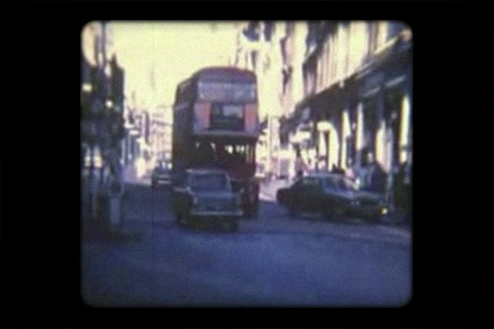
MARTIN SEXTON
Martin Sexton is a London-based artist and writer who began his career as a science-fiction writer. Without a formal background in fine art, Sexton considers his point of view to be more akin to that of a writer. Or as John-Paul Pryor of DAZED Digital has described, Sexton is “a raconteur of both constructed and real mythologies.” Sexton calls his works ‘futiques,’ a portmanteau alternatively evoking the terms future, critique, and antique. Sexton’s futiques are filmed in the past, screened in the present, and bear portents from the future. The layering of multiple temporalities in Sexton’s videos, along with his narrative strategies (primarily scrolling first-person text) lend them an ambivalent presence: who, or what, exactly can we consider the author? Sexton’s first encounter with MOMENTUM was at MOMENTUM Sydney in 2010, where curator James Putnam included “Bloodspell (Mexican UFO)” (1972-2012) as part of The Putnam Selection, a program of seven films by British artists. In 2012, Sexton donated “Bloodspell (Mexican UFO)” and “Indestructible Truth (Tibet UFO)” (1958-59) to the MOMENTUM Collection. When the MOMENTUM Collection was shown at the Musraramix Festival in Jerusalem in May 2012, Sexton traveled to Jerusalem to represent the artists in the collection.
Bloodspell (Mexican UFO), 1973 – 2012
With its low-fi analogue aesthetic and jerky zoom shots, “Bloodspell (Mexican UFO)” (1973-2012) begins like your parents’ home travel videos. Characteristically of Sexton’s videos, however, our cameraman himself does not appear. Instead, a scrolling first-person narrative describes a remote Mayan temple controlled by the cosmos. The lasting enigma of “Bloodspell” comes towards the video’s end, as the camera transitions from its documentary role into a tool of abstraction and mysticism. As the music swells and kaleidoscope-like patterns drift across the screen, we watch a flying saucer land on top of a Mayan temple. Without comment or guidance from the narrator, Sexton leaves us to probe our own potential for belief or disbelief.
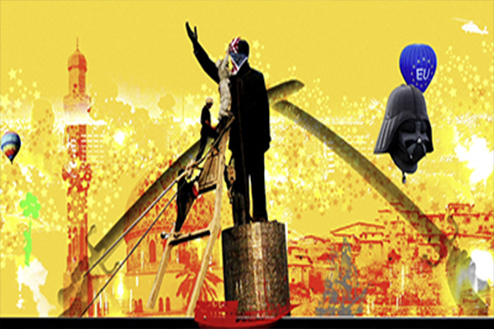
SUMUGAN SIVANESAN
Sumugan Sivanesan is a self-described ‘anti-disciplinary’ artist and a transcultural radical. His eclectic practice is concerned with the legacies of colonialism, the experience of cultural difference, and diaspora. Sivanesan often engages with the theory of ‘necropolitics’ coined by the Cameroonian philosopher and political scientist Achille Mbembe. Building upon and going beyond the Foucauldian notion of biopower, the domain of life over which power has taken control, ‘necropolitics’ asserts that contemporary forms of subjugation of life to the power of death has reconfigured the relationships between resistance, sacrifice, and terror. Sivanesan’s first collaboration with MOMENTUM was during MOMENTUM Sydney in 2010, where he performed “What’s Eating Gilberto Gil” (2010), a performance/lecture exploring our common history of cannibalism and its contemporary legacies. In February 2012, Sivanesan proposed to perform a new work, “The Anticolonials” (2012) at MOMENTUM Berlin. “The Anticolonials” traced the past and present of anti-colonial politics. Along with his new performance/lecture, MOMENTUM exhibited a retrospective of Sivanesan’s video works.
A Children’s Book of War, 2010
A Children’s Book of War made its fortuitous entrance into the MOMENTUM Collection while curator Rachel Rits-Volloch was in the process of organizing Sivanesan’s video retrospective at MOMENTUM. After spending the day with Sivanesan reviewing his videos, Rits-Volloch asked him to play a neglected yellow icon on his desktop. While Sivanesan insisted that the work was merely a short animation, quite different from his other works, Rits-Volloch immediately registered the impact of the work. The immediate impact of A Children’s Book of War lies, perhaps, in its jarring conjunction of war, sovereignty, and violence with a format usually reserved for much more lighthearted topics. With its dominant color palette of black and bright yellow, A Children’s Book of War incorporates iconography as diverse as Julian Assange, the Sydney Opera House, and the frontispiece of Thomas Hobbes’ Leviathan. In the accompanying text to the work, Sivanesan draws upon Giorgio Agamben’s notion of the “state of exception” to discuss 9/11, Australia entering the Iraq War in 2003, the 2010 Haiti earthquake, and the first fateful contact that Captain Cook made in Australia. The “state of exception,” in short, is the temporary suspension of the rule of law in the name of a greater force – whether that be a defense against insurrectionary forces or the preservation of the very constitution of a sovereignty. With its haunting last paragraph, Sivanesan reminds us that the sovereignty of Australia rests on the suspension of indigenous rights – indeed, that everywhere in the Western world our lives are made possible by suspensions that are felt and suffered always elsewhere:
“When Captain Cook first made contact, 18 years before Governor Phillip and the First Fleet arrived an act of violence pre–empted the war that was to follow.
It’s a war that a lack of recognition of Indigenous Sovereignty helps to perpetuate.
A war that the civic revolt at Redfern revealed. A war not likely to end any time soon.”
About Millerntor Gallery

The Millerntor Gallery is the international urban arts, music and cul-ture festival for creative engagement. Initiated by Viva con Agua and the FC Sankt Pauli, it is both a social art gallery and a cultural festival in the Millerntor stadium. Various target groups are addressed and moti-vated to engage themselves socially, through the universal languages of art, music and football. For 5 days a year, the Millerntor stadium is transformed into a platform for dialogue and exchange, locally, inter-nationally as well as at an intercultural level.
By means of trans-genre art works, film presentations and a diverse musical, cultural and edu-cational programme, it aims to address the question of how a positive change to the world can be instigated. Thereby, opportunities of inter-action and participation turn the audience into participants, and cre-ate a meaningful community, even beyond the event itself. The profits generated by the art sales are donated to Viva con Agua e.V., in order to improve the worldwide water and sanitary supply.


 Back to Homepage
Back to Homepage

